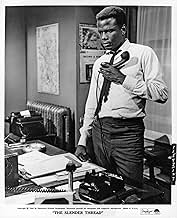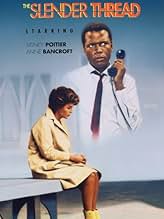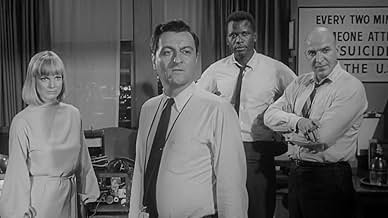IMDb-BEWERTUNG
7,0/10
2606
IHRE BEWERTUNG
Der Freiwillige Alan arbeitet eines Abends allein im Krisenzentrum, als er einen Anruf von der selbstmordgefährdeten Anruferin Inga Dyson erhält.Der Freiwillige Alan arbeitet eines Abends allein im Krisenzentrum, als er einen Anruf von der selbstmordgefährdeten Anruferin Inga Dyson erhält.Der Freiwillige Alan arbeitet eines Abends allein im Krisenzentrum, als er einen Anruf von der selbstmordgefährdeten Anruferin Inga Dyson erhält.
- Regie
- Drehbuch
- Hauptbesetzung
- Für 2 Oscars nominiert
- 2 Gewinne & 4 Nominierungen insgesamt
H.M. Wynant
- Doctor Morris
- (as H.N. Wynant)
Bob Hoy
- Patrolman Steve Peters
- (as Robert Hoy)
Empfohlene Bewertungen
The late Sydney Pollack tried his hand at several different genres and succeeded in most; since he never demonstrated an individualistic style (for many he was the antithesis of an auteur!), he could adapt himself to virtually anything (and Pollack often set his sights on grand themes) – though the end result would always be somewhat artificial (if undeniably slick) because of the director’s impersonal approach!
Anyway, for his debut film, he settled on an intimate melodrama – shot on location in glorious black-and-white (incidentally, all his subsequent work would be in color). The plot is simple: Sidney Poitier is a student who works nights at a Seattle Crisis Clinic; on one occasion, a call comes in where a wealthy socialite at the end of her tether (Anne Bancroft) declares she has deliberately overdosed on barbiturates! She phoned not so much because she wanted help but rather so that someone will know of her outcome; Poitier, however, determines to keep her on the line – while he sets in motion a complex operation in order to trace Bancroft’s whereabouts and save her life.
For about the first third of the film, Bancroft barely appears: we only hear her world-weary voice booming across the room at the clinic, Poitier having switched the call to the loudspeaker; eventually, she starts to let her hair down and, in intermittent flashbacks, we see her movements during the last few days (which boils down to her alienation from familial cords due to a past mistake which has come back to haunt her). While this was certainly a way to do it, I’m baffled as to why we never cut to where Bancroft is now until the last act: consequently, we have to contend with a fair bit of padding during the ‘re-enactments’ (which could have easily been covered via dialogue delivered by the heroine)! That said, I guess it was a conscious decision on Pollack’s part to ‘open up’ the drama (not merely to include other characters – most prominently, Steven Hill as the woman’s husband – but also to utilize a number of exteriors, where he was able to exercise a keen eye for realistic detail).
Still, the film compels attention despite an essentially contrived central situation: for instance, at this point, it’s best not to go into how Bancroft manages to remain lucid for so long or, even more importantly, why she just doesn’t hang up on Poitier; and what about the plausibility of the latter’s temper-tantrums (to the exasperation of clinic psychiatrist Telly Savalas!) to coerce the woman into reacting, thus hanging on to life in spite of herself? But that’s Hollywood for you…and, in a talky film such as this, the emphasis is on the writing (by Stirling Silliphant) and the acting (Bancroft is typically excellent and Poitier’s contribution, amounting to a variation on his PRESSURE POINT [1962] role, just as good if slightly overstated in the long run). Even so, as a counter-balance to the ongoing histrionics, reasonable suspense – aided by up-to-date methods of detection – is generated throughout by the race-against-time to locate Bancroft.
At the end of the day, THE SLENDER THREAD emerges as a quite impressive (and generally still powerful) first outing – recalling the gritty work of many a contemporary film-maker who, like Pollack, had emerged from TV.
Anyway, for his debut film, he settled on an intimate melodrama – shot on location in glorious black-and-white (incidentally, all his subsequent work would be in color). The plot is simple: Sidney Poitier is a student who works nights at a Seattle Crisis Clinic; on one occasion, a call comes in where a wealthy socialite at the end of her tether (Anne Bancroft) declares she has deliberately overdosed on barbiturates! She phoned not so much because she wanted help but rather so that someone will know of her outcome; Poitier, however, determines to keep her on the line – while he sets in motion a complex operation in order to trace Bancroft’s whereabouts and save her life.
For about the first third of the film, Bancroft barely appears: we only hear her world-weary voice booming across the room at the clinic, Poitier having switched the call to the loudspeaker; eventually, she starts to let her hair down and, in intermittent flashbacks, we see her movements during the last few days (which boils down to her alienation from familial cords due to a past mistake which has come back to haunt her). While this was certainly a way to do it, I’m baffled as to why we never cut to where Bancroft is now until the last act: consequently, we have to contend with a fair bit of padding during the ‘re-enactments’ (which could have easily been covered via dialogue delivered by the heroine)! That said, I guess it was a conscious decision on Pollack’s part to ‘open up’ the drama (not merely to include other characters – most prominently, Steven Hill as the woman’s husband – but also to utilize a number of exteriors, where he was able to exercise a keen eye for realistic detail).
Still, the film compels attention despite an essentially contrived central situation: for instance, at this point, it’s best not to go into how Bancroft manages to remain lucid for so long or, even more importantly, why she just doesn’t hang up on Poitier; and what about the plausibility of the latter’s temper-tantrums (to the exasperation of clinic psychiatrist Telly Savalas!) to coerce the woman into reacting, thus hanging on to life in spite of herself? But that’s Hollywood for you…and, in a talky film such as this, the emphasis is on the writing (by Stirling Silliphant) and the acting (Bancroft is typically excellent and Poitier’s contribution, amounting to a variation on his PRESSURE POINT [1962] role, just as good if slightly overstated in the long run). Even so, as a counter-balance to the ongoing histrionics, reasonable suspense – aided by up-to-date methods of detection – is generated throughout by the race-against-time to locate Bancroft.
At the end of the day, THE SLENDER THREAD emerges as a quite impressive (and generally still powerful) first outing – recalling the gritty work of many a contemporary film-maker who, like Pollack, had emerged from TV.
I believe that this was Sydney Pollack's directorial debut. If so, then he certainly gave an interesting insight into his future work. Seattle college student Alan Newell (Sidney Poitier) is working at a crisis hotline center when he gets a call from housewife Inge Dyson (Anne Bancroft), who is reaching the breaking point. Because they can't see each other, it gives the movie a real sense of tension, as implied by the title - even if it drags a little bit at times.
A previous reviewer said that Poitier plays his usual role: a morally superior black man in a white-dominated society. That's partly true, but here, he has a job that anyone could have, and his race doesn't really matter (although as the reviewer noted, they could have been subtly talking about race). As for Anne Bancroft, her death six months ago brings her filmography to mind. This may have not been her most famous role, but I would recommend it.
A previous reviewer said that Poitier plays his usual role: a morally superior black man in a white-dominated society. That's partly true, but here, he has a job that anyone could have, and his race doesn't really matter (although as the reviewer noted, they could have been subtly talking about race). As for Anne Bancroft, her death six months ago brings her filmography to mind. This may have not been her most famous role, but I would recommend it.
I remember seeing this film a few years ago and it stuck with me for some reason. looking at it again, i know why. The whole thing has a mid-1960s melancholy to it, almost with a tinge of the horror films that would emerge in the late 1960s, like rosemary's baby, or, roman polanski's first horror film 'repulsion' which was made in the same year as slender thread. one of the most amazing things about this film is the opening sequence which uses all kinds of staples of film shooting styles and techniques of the mid-late 60s, which themselves add a melancholic tone to the film. There is the space needle, which looks positively cold-war futuristic with the car going up the side of it; the world's fair architecture with its modernist water fountains--which foreground the first shot a desperate-looking Anne Bancroft, and of course, the locks, dams and highways of the Seattle waterfront. You can't help but get nostalgic seeing the Seattle of this time. Not to mention that Anne Bancroft's husband is a fisherman. I've never been to Seattle but i'm pretty sure most of this stuff is gone. (wasn't there some attempt to save the old docks in a big standoff in 1964?). If you want to see another view of Seattle in the early 70s, I recommend seeing "Cinderella Liberty" with James Caan. Then there are even more visual and aural elements which help create the mood: the shots of the 'backroom' of the telephone company--with its immense network of phone lines--actual physical lines!--and the women operators unplugging and plugging cables to connect one line to another. These are bygone days! You wonder if Sydney Pollack wasn't subtly, or not so subtly, making a comment on the postwar bureaucratized society itself. Another treat is the 'Hyatt hotel' sign towards the end of the film. Total 1960s visual. And of course, Quincy Jones' soundtrack with some great Sam and Dave-style jazzy organ music.
Visuals aside, this is a great film. Again, dealing with some rather dark issues. The scene where Anne Bancroft comes home and sees her husband in the living room looking depressed...you don't know if he's having a psychotic episode, has lost his job or is on LSD. Anne Bancroft, overall, is a disturbing character. Perhaps more disturbing is that she would play another tragic character two years later - Mrs. Robinson, in The Graduate. Sidney Poitier is in usual form - the studious, morally-superior black in a predominantly white setting. I like what someone else here said - that the film very subtly has a subtext on race (how could a 1960s film showing blacks and whites in the same frame not? How could we as Americans not read race into the film?) while never dealing with race explicitly. This is actually one reason I think Sidney Poitier's characters and films are an important, and yet lost, representation of race relations. For all the flack that he got in the racially charged mood of the 1960s as an assimilationist good black who whites could accept, especially as he was the first black protagonist in films (it didn't help that he was West Indian, having grown up in the Bahamas). to me I still see some kind of Caribbean AND Black persona in his characters which I think he 'sneaks in' in subtle ways. His classic move is some breaking point at which he can't take any more -- whether its racial bigotry, disrespect for authority, or something else -- and he delivers some great speech of moral indignation. He does it in 'pressure point', in 'to sir with love', 'in the heat of the night', and maybe a few others. It may be pretentious at times, but this 'style' disappeared after the late 60s as blaxploitation with its overly masculinized and violent characters became the dominant representation in film.
Anyway, all the political and social analysis aside, this is really a great film.
Visuals aside, this is a great film. Again, dealing with some rather dark issues. The scene where Anne Bancroft comes home and sees her husband in the living room looking depressed...you don't know if he's having a psychotic episode, has lost his job or is on LSD. Anne Bancroft, overall, is a disturbing character. Perhaps more disturbing is that she would play another tragic character two years later - Mrs. Robinson, in The Graduate. Sidney Poitier is in usual form - the studious, morally-superior black in a predominantly white setting. I like what someone else here said - that the film very subtly has a subtext on race (how could a 1960s film showing blacks and whites in the same frame not? How could we as Americans not read race into the film?) while never dealing with race explicitly. This is actually one reason I think Sidney Poitier's characters and films are an important, and yet lost, representation of race relations. For all the flack that he got in the racially charged mood of the 1960s as an assimilationist good black who whites could accept, especially as he was the first black protagonist in films (it didn't help that he was West Indian, having grown up in the Bahamas). to me I still see some kind of Caribbean AND Black persona in his characters which I think he 'sneaks in' in subtle ways. His classic move is some breaking point at which he can't take any more -- whether its racial bigotry, disrespect for authority, or something else -- and he delivers some great speech of moral indignation. He does it in 'pressure point', in 'to sir with love', 'in the heat of the night', and maybe a few others. It may be pretentious at times, but this 'style' disappeared after the late 60s as blaxploitation with its overly masculinized and violent characters became the dominant representation in film.
Anyway, all the political and social analysis aside, this is really a great film.
I enjoyed the film not only for its taught and gripping story line; but also for the director's imaginative filming technique. The Slender Thread is unique in it's actual "threading" of actors, particularly, who become much bigger in life as their careers flourish. I always enjoy the chance to see an actor/actress before they go on to fame. Stephen Hill is one of those.
Although not a true film noir; the black and white filming for me adds to the total involvement of the viewer and gives a heightened perspective to the whole cinema outing.
I suggest the film highly. The interactions between cast are worth the view.
Although not a true film noir; the black and white filming for me adds to the total involvement of the viewer and gives a heightened perspective to the whole cinema outing.
I suggest the film highly. The interactions between cast are worth the view.
Sydney Pollack's first feature directorial debut after years of directing episodic television is crisp, tense, and generally very well-acted. Anne Bancroft plays a woman facing a turning point hard to cope with in her life and Sidney Poitier plays a young college student raking in hours at a suicide hot-line extending a figurative helping hand. Though the two great actors share no scenes together - they have a certain chemistry as they talk, talk, and talk on the phones, and we are given flashback sequences showing us how and why Bancroft is fighting her new found depression. Though the story itself is rather mundane in terms of the impetus for her disposition, the dialog and performances easily make up for any inadequacies. Both Bancroft and Poitier really shine in their roles and the rest of the cast - especially Telly Savalas do fine work. It is evident that Pollack was honing his craft but also possessed a great deal of ability in terms of framing a shot and creating a strong pace and presence throughout the picture.
Wusstest du schon
- WissenswertesThis film shows the tedious process in 1965 of what was required in tracing a telephone call on actual central office equipment that was state of the art such as number 5 cross bar and step-by-step electro/mechanical equipment. It was filmed in central offices of the old Northwest Bell Telephone company which as of 2010 is now Century Link. Modern telephone switching equipment can trace a call in less than a minute or even 30 seconds.
- PatzerAfter Inga attempts suicide by drowning herself in the bay, she arrives at hospital with perfectly styled hair.
- Zitate
Mark Dyson: [to Inga] Do you think that not getting caught in a lie is the same as telling the truth?
- VerbindungenFeatured in Große Regisseure: The Films of Sydney Pollack (2000)
Top-Auswahl
Melde dich zum Bewerten an und greife auf die Watchlist für personalisierte Empfehlungen zu.
- How long is The Slender Thread?Powered by Alexa
Details
- Laufzeit1 Stunde 38 Minuten
- Farbe
- Sound-Mix
- Seitenverhältnis
- 1.85 : 1
Zu dieser Seite beitragen
Bearbeitung vorschlagen oder fehlenden Inhalt hinzufügen





































